
Intelligente.
Sans fil.
Autonome.
Solution de détecteurs IdO de qualité industrielle alimentée par batterie et dotée de la technologie LoRaWAN® pour une utilisation en extérieur.
WILSEN.sonic, pour des mesures de distance et de niveau intelligentes


Technologie LoRa standardisée

Installation et utilisation faciles
Précision et flexibilité maximales
Applications
Villes et industries intelligentes
Gestion des déchets
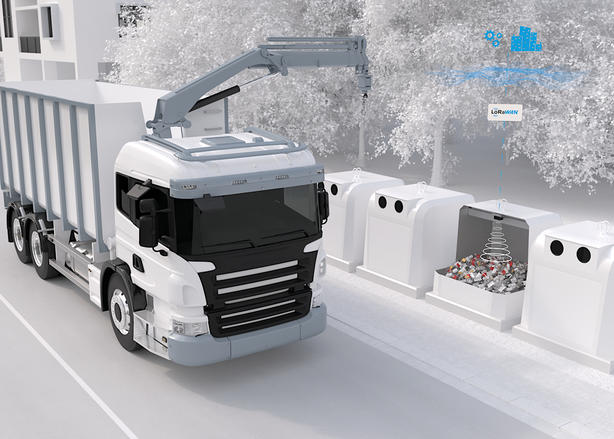
Les exigences imposées aux villes et aux municipalités pour fournir aux citoyens des modes de vie pratiques et respectueux de l'environnement sont de plus en plus nombreuses. Les détecteurs WILSEN.sonic permettent une gestion intelligente de la mise au rebut, dans laquelle les niveaux de remplissage des conteneurs à verre usagé, vieux vêtements et matières recyclables sont contrôlés à distance. Ainsi, les conteneurs ne sont collectés qu'une fois remplis à une quantité définie. Cela permet une planification plus efficace des itinéraires et réduit ainsi les émissions, les embouteillages et le bruit dans les zones urbaines.
Ce concept peut également être appliqué aux grands locaux professionnels des entreprises de fabrication qui ont recours à un grand nombre de conteneurs de recyclage. L'intégration de détecteurs IdO WILSEN.sonic permet d'optimiser les processus internes de gestion des déchets, et ainsi de gagner du temps et de l'argent.
Silos et réservoirs de stockage
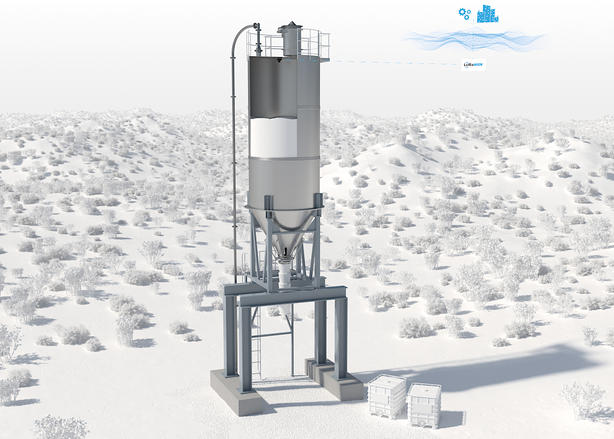
Qu'il s'agisse de détecter des matériaux en vrac de différents types ou des liquides, les détecteurs WILSEN.sonic à batterie constituent pour les institutions publiques et les entreprises industrielles une solution efficace pour obtenir des informations sur une grande variété de conteneurs sans avoir à recourir à un câblage complexe.
En fonction du type et de la taille du conteneur, les produits Pepperl+Fuchs sont proposés en différentes variantes WILSEN.sonic, dans différentes gammes. Les versions affichant une plage de détection allant jusqu'à 2 500 mm sont idéales pour les grands récipients pour vrac (GRV) compacts. La version WILSEN.sonic affichant une plage de détection allant jusqu'à 7 000 mm, quant à elle, est utilisée dans les grands réservoirs de stockage tels que le silo à sel illustré ici. Grâce à l'indice de protection élevé (IP66/67), les détecteurs sont protégés efficacement et en continu contre la pénétration de liquides ou de particules de poussière dans les conteneurs.
Environnement intelligent
Bassins de rétention d'eaux pluviales
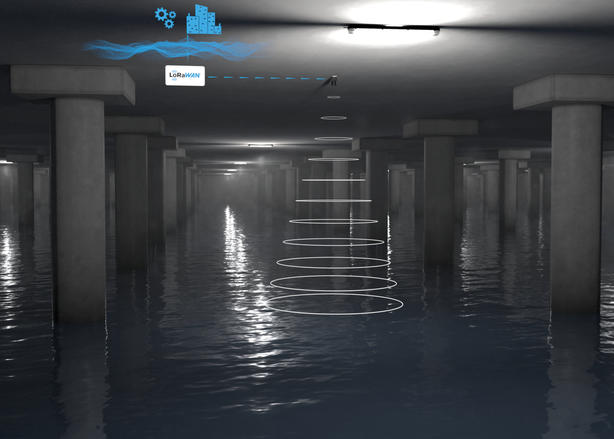
Dans les zones urbaines presque entièrement recouvertes de béton, les bassins de rétention d'eaux pluviales souterrains servent à absorber les fortes précipitations et éviter les inondations. Les détecteurs WILSEN.sonic permettent de surveiller efficacement le niveau d'eau dans ces réservoirs : installé sur le plafond du bassin de rétention, sans aucun fil, le détecteur est conçu pour résister à l'immersion dans l'eau (classe de protection IP66/67). Les valeurs mesurées sont transmises en toute fiabilité à l'extérieur du bassin souterrain. La batterie haute performance longue durée intégrée dure plusieurs années, évitant ainsi au personnel d'entretien des interventions chronophages répétées pour la remplacer.
Grâce à sa longue portée de transmission, le WILSEN.sonic est également capable de transmettre les niveaux de remplissage à la passerelle LoRa la plus proche, même à partir de bassins de rétention d'eaux pluviales hors-sol éloignés. La large plage de températures de -25 … 70 °C garantit le bon fonctionnement du détecteur même en plein soleil ou dans des conditions hivernales rigoureuses.
Protection contre le risque d'inondation
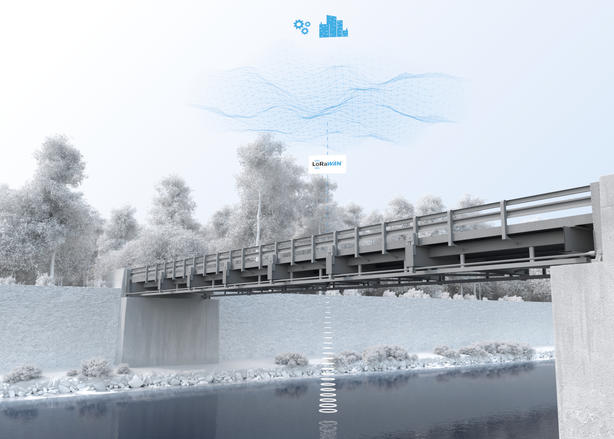
Le risque d'inondations importantes est omniprésent dans de nombreuses zones proches de grands cours d'eau. Les détecteurs WILSEN.sonic peuvent jouer un rôle essentiel face à un tel danger. Ces détecteurs transmettent non seulement les niveaux d'eau, mais aussi leur géolocalisation. Cela permet de collecter les données de divers détecteurs installés sur des ponts, par exemple, et de les corréler afin d'obtenir une évaluation précise.
Ces analyses précises de l'évolution des niveaux d'eau individuels et l'inclusion de données météorologiques historiques et actuelles permettent à des modèles d'IA de prédire avec précision quand et où des inondations sont susceptibles de se produire. Cela permet de prendre les mesures de protection nécessaires avant que des situations de crise ne surviennent. La prise en compte des données météorologiques en temps réel permet d'ajuster automatiquement l'intervalle de transmission des détecteurs afin qu'ils transmettent des données moins fréquemment lorsque les conditions météorologiques sont bonnes et qu'ils en envoient plus souvent lorsque des précipitations sont prévues. Cela permet aux batteries longue durée de durer encore plus longtemps.
Agriculture intelligente
Silos à aliments
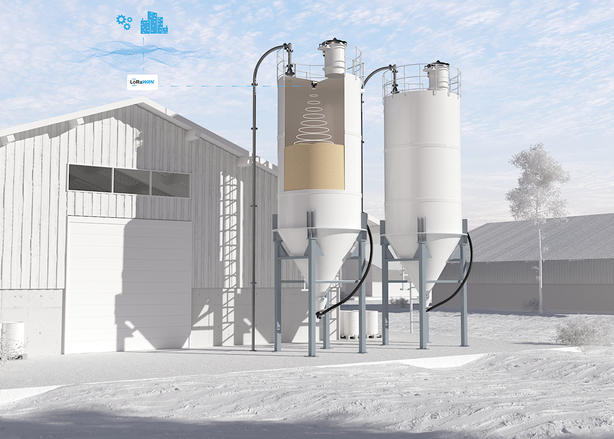
Dans les silos agricoles, l'on frappe généralement la couche extérieure du contenu à l'aide d'un maillet en caoutchouc ou d'une tige afin d'estimer le niveau de remplissage en fonction de la résonance acoustique. Il s'agit bien évidemment d'une méthode beaucoup moins précise qu'une solution de détection et, dans le cas de hauts silos, cela engendre un risque d'accidents dû à l'utilisation d'échelles verticales. Toutefois, l'installation d'une solution de détection sur ces silos peut parfois sembler trop compliquée ou source d'erreurs : outre le problème de l'acheminement d'une alimentation jusqu'au silo, les conditions ambiantes difficiles et la projection possible de résidus sur le détecteur rendent l'utilisation de nombreux types de détecteurs sans contact quasiment impossible. Quant aux solutions employant des détecteurs mécaniques, elles sont sujettes à l'usure des pièces mobiles.
C'est là que le WILSEN.sonic entre en jeu : le détecteur ultrasonique sans fil, qui ne nécessite aucune alimentation externe, se monte facilement en haut du silo à l'aide de la plaque de montage fournie et transmet en continu des relevés de niveau par radio. Dans le cas peu probable où des poussières se déposeraient sur le transducteur à faible adhérence du détecteur, elles n'ont généralement aucun effet sur la fiabilité des résultats de mesure grâce au principe de fonctionnement ultrasonique à faible interférence. Avec sa large plage de températures de -25 … 70 °C et son indice de protection IP66/67, le détecteur résiste aux fluctuations de température à l'intérieur du silo ainsi qu'aux nettoyages de l'intérieur du silo à l'eau.
Fosses à lisier
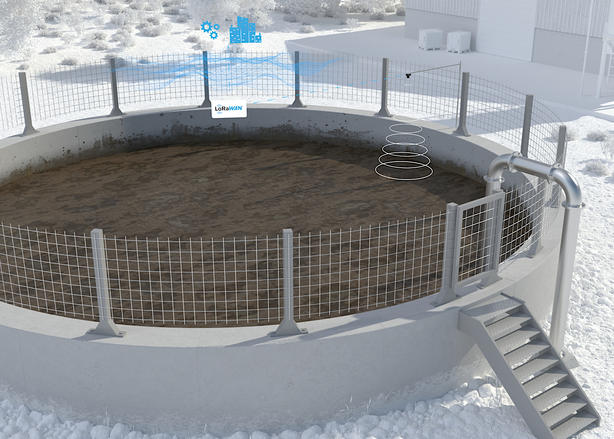
La surveillance et le vidage des fosses à lisier font partie de la vie d'une exploitation. Cela se fait généralement sur la base de l'expérience et d'inspections visuelles régulières. Cependant, il arrive parfois que l'on oublie cette tâche pendant quelque temps, qu'un robinet intermédiaire ne se ferme pas correctement ou que la fosse déborde en raison de fortes pluies inattendues. Cela entraîne un surplus de travail non planifié, une contamination du sol et même, dans le pire des cas, des poursuites pour négligence.
Les détecteurs WILSEN.sonic permettent de minimiser facilement ce risque. Il suffit de monter un détecteur sur une flèche au-dessus de la fosse à lisier pour surveiller en continu la conformité avec les valeurs limites. En cas de dépassement de la valeur limite, l'agriculteur est averti par la plate-forme IdO en aval. La conception robuste (transducteur recouvert de PTFE, indice de protection IP66/67 et large plage de températures de -25 … 70 °C) est parfaitement adaptée à cette application extérieure difficile.
Exemples de projets…
Plus de transparence, des itinéraires optimisés, une surveillance fiable des niveaux et des modèles de données avancés : le détecteur ultrasonique intelligent WILSEN ouvre de nouvelles perspectives en matière de gestion des déchets par les municipalités, de gestion des eaux usées et de protection contre le risque d'inondation. Voici plusieurs projets mis en œuvre avec succès.
L'expérimentation « Smart Region du Land de Bade » est un projet conjoint de badenovaNETZE et Thüga. Dans le cadre de cette initiative, plusieurs applications de ville intelligente ont été mises en œuvre avec le partenaire E-MAKS. Cela comprenait l'optimisation des itinéraires de collecte des conteneurs à verre dans le secteur de Fribourg. Le détecteur WILSEN de Pepperl+Fuchs a été mis en œuvre avec succès dans le cadre de ce projet.
En savoir plus (en allemand uniquement)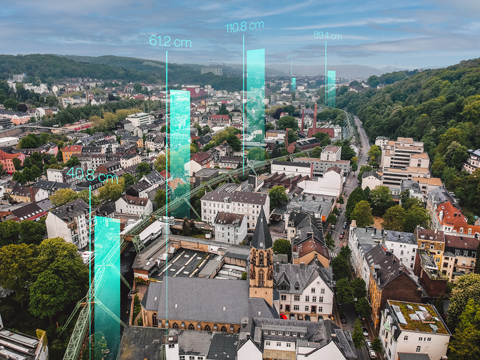
La surveillance de conteneurs n'est pas la seule application des détecteurs WILSEN : dans la zone entourant la ville de Wuppertal, ils sont au cœur d'un projet novateur en matière de protection contre le risque d'inondation. Les données de niveau transmises par les détecteurs sont intégrées à un modèle d'IA qui permet de prévoir à l'avance les risques d'inondations.
En savoir plus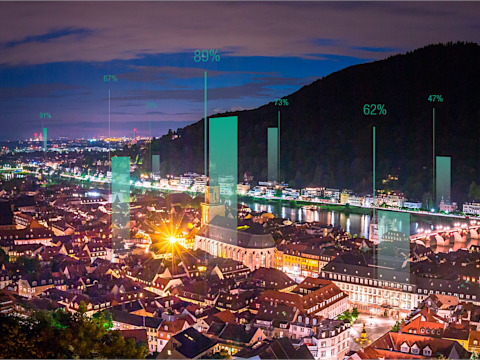
Pour permettre un vidage intelligent et à la demande des conteneurs de déchets dans la ville de Heidelberg, Pepperl+Fuchs a développé, en collaboration avec ses partenaires SAP et Smart City Solutions, une solution qui utilise la technologie ultrasonique et LoRaWAN®. Cette solution inclut le module de base WILSEN actuel.
En savoir plus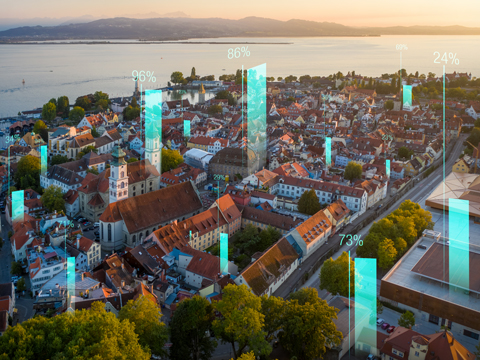
Le détecteur WILSEN de REMONDIS Aqua situé à Lindau, sur le lac de Constance, assure une évaluation approfondie des égouts et des arbres. Le détecteur surveille les rejets d'eau externe dans le réseau d'eaux usées. Il fournit également toute une série de données qui servent à étalonner les modèles d'eaux usées hydrauliques.
En savoir plus (en allemand uniquement)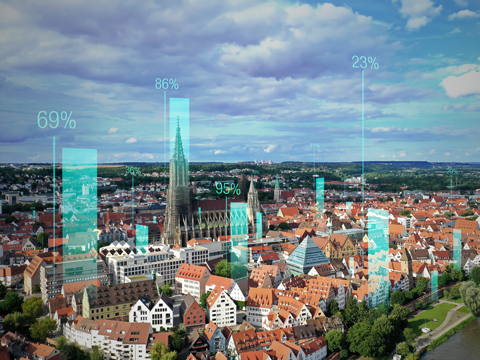
Dans le « LoRa Park », la ville d'Ulm met à la disposition de tous un endroit où ils peuvent expérimenter des solutions basées sur la détection pour l'Internet des objets. L'on peut notamment y découvrir la détection et la transmission des niveaux de remplissage des collecteurs de bouteilles grâce aux produits WILSEN.
En savoir plus (en allemand uniquement)Comment cela fonctionne-t-il ?
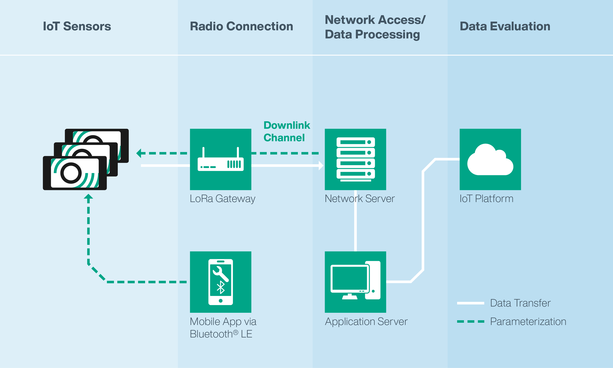
Un réseau étendu à longue portée (LoRaWAN, Long Range Wide Area Network) est requis pour transférer les valeurs mesurées par les détecteurs IdO WILSEN vers une plate-forme IdO basée sur le cloud et les évaluer au même endroit. Ces réseaux facilement évolutifs, entièrement adaptés aux exigences de l'Internet des objets, se caractérisent par leur faible consommation d'énergie, leur longue portée et leur communication sécurisée.
En plus des détecteurs IdO et autres appareils finaux, une telle architecture LoRaWAN est généralement constituée de passerelles longue portée disposées en étoile. Ces passerelles convertissent les données des détecteurs WILSEN en protocole Ethernet et transmettent les informations converties à un serveur réseau LoRa. Le serveur réseau décode les données des détecteurs et les transfère à un serveur d'applications où elles subissent un traitement initial avant leur évaluation finale sur une plate-forme IdO.
Dans le même temps, la communication en sens inverse est également possible via le serveur réseau LoRa et les passerelles : il est non seulement possible de recevoir les données des détecteurs, mais également de modifier les réglages des détecteurs WILSEN à distance via ce que l'on appelle le « canal de liaison descendante ». Pepperl+Fuchs propose un service Web gratuit dédié.
Les détecteurs peuvent également être paramétrés directement sur site via une application pour appareil mobile.
Videos
Battery-Powered IoT Sensor Solution for Outdoor Use
The wireless, autonomous WILSEN IoT sensors reliably supply data regarding fill level, distance, valve position, and object presence to a LoRaWAN without a cable connection. Learn more about their functional principle and unique features.
Parameterization of WILSEN Sensors via the Downlink Channel
How do you parameterize the WILSEN sensors from Pepperl+Fuchs via the downlink channel? In this video, our expert shows you how to set it up quickly and easily.
LoRaWAN®
Une technologie compatible avec l'Internet des objets qui présente de nombreux avantages
En tant que membre de la LoRa Alliance®, Pepperl+Fuchs s'engage à assurer l'interopérabilité des produits et le déploiement mondial de cette technologie.
La technologie LoRa présente un certain nombre d'avantages particulièrement adaptés à une utilisation avec des détecteurs IdO tels que les détecteurs WILSEN de Pepperl+Fuchs :
- Connexion d'appareils jusqu'à 15 km de distance
- Disponibilité mondiale et indépendance vis-à-vis des fournisseurs
- Puissance minimale requise pendant la transmission
- Transfert de données par radio, aucun câblage de détecteur requis
- Sécurité et intégrité élevées
- Faibles coûts d'exploitation
Grâce à de telles propriétés, la technologie LoRa peut servir à créer de très grands réseaux sans fil afin de mettre en œuvre des applications pour les villes, les municipalités et des industries diverses. Elle permet également de mettre en place des réseaux privés économiques dans les locaux professionnels.

Nos partenaires
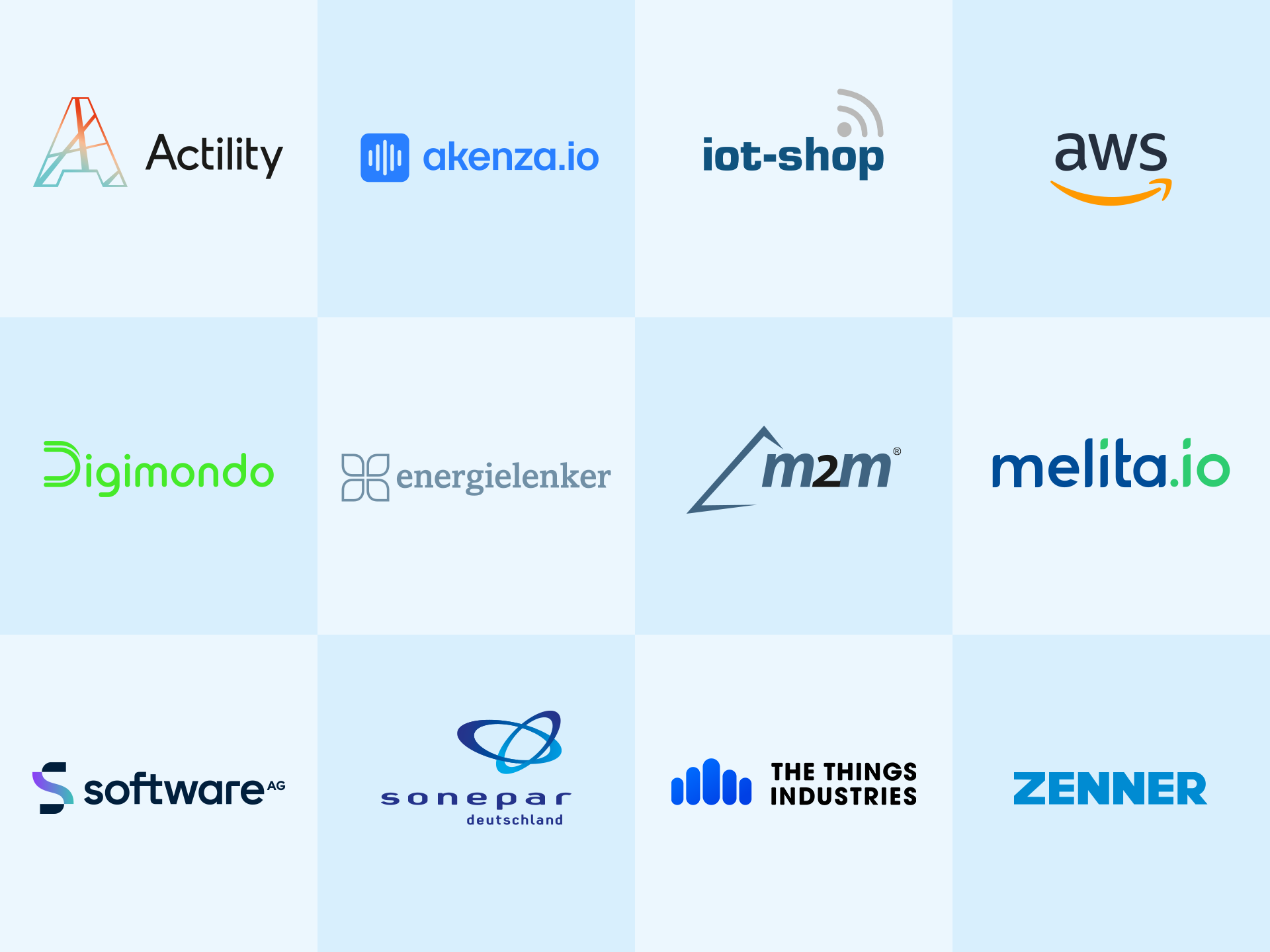
Notre solide réseau est constitué d'un large éventail de partenaires dans les secteurs des technologies LoRa et IdO. Bénéficiez de l'expertise combinée de Pepperl+Fuchs et de ces partenaires renommés pour la mise en œuvre de tous vos projets.
Des services au cœur de votre réussite
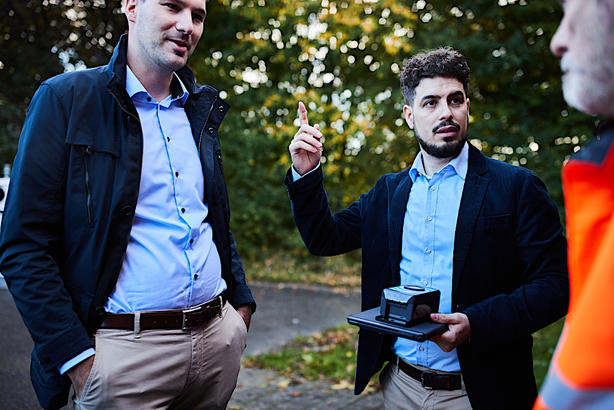
Les détecteurs ultrasoniques de Pepperl+Fuchs sont intégrés à notre propre centre technologique, où nous développons et fabriquons des transducteurs. Depuis plus de 30 ans, notre équipe d'experts visionnaire travaille en permanence à l'amélioration de la technologie ultrasonique pour les solutions de demain. Cela signifie que nos clients reçoivent toujours les produits les plus performants du marché.
Nous ne vous proposons pas seulement une véritable excellence technique, mais également un service et une assistance de premier ordre, portés par notre présence mondiale, notre connaissance approfondie des différentes industries et notre orientation client. Bien entendu, cela s'applique également à notre gamme de détecteurs WILSEN : dans cette section, vous trouverez toute une sélection d'outils pour vous aider à tirer le meilleur parti de vos détecteurs tout en limitant les coûts d'exploitation.




 Plus d'informations
Plus d'informations Téléchargements
Téléchargements

 +33 1 60921300
+33 1 60921300